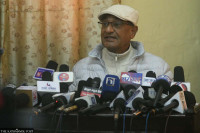National
Nepal-China to meet on cross-border transmission line in two weeks
The third round of bilateral meeting is scheduled to take place after a gap of three years.
Prithvi Man Shrestha
Nepal and China are scheduled to hold another round of discussions later this month on the development of a cross-border transmission line between the two countries.
A Joint Technical Group comprising representatives of the Nepal Electricity Authority and the State Grid Corporation of China had previously held two rounds of talks in China and Nepal, respectively, on the issue before the Covid-19 pandemic.
Another meeting scheduled to be held in China did not materialise due to continued Covid restrictions in China in the past three years.
The last meeting was held in March 2020, when the officials of the State Grid Corporation of China visited Nepal before Nepal imposed its first lockdown.
But NEA officials said that the next meeting will be of the Joint Working Group, which is the upgraded joint mechanism under which a Joint Technical Group and Joint Commercial Group operate.
“We agreed on the proposal of the Chinese side on holding the next meeting in Nepal in February and it has now been scheduled to be held in the third week of February,” said Komal Nath Atreya, chief of the Ratamate-Rasuwagadhi-Kerung Transmission Line Project at Nepal Electricity Authority (NEA). “We have not fixed the exact date as flights are being arranged for the Chinese team to visit Nepal.”
Currently, flights between Nepal and China are limited with most being suspended since the outbreak of Covid-19 in 2020.
Amid concerns over Nepali officials being required to stay in quarantine for several days in China, the Chinese side proposed holding the next round of meeting in Nepal, said Atreya.
Dirghayu Kumar Shrestha, chief of the transmission directorate at the NEA, also confirmed that the talks are scheduled for the third week of February. “It is the meeting of the joint working group, the joint mechanism upgraded when the agreement was extended last year,” Shrestha, who will lead the Nepali team during the negotiation, said.
With China adopting a strict Zero Covid policy in the past three years, in-person meetings between the two sides had not been possible.
China eased Covid-19 restrictions in December last year, paving the way for the planned arrival of Chinese teams to hold talks. “We are holding discussions on finalising the agenda for the upcoming meeting,” said Atreya.
According to him, some of the issues they will discuss with the Chinese include a briefing on the progress made by both sides on the construction of a cross-border power line since the last meeting in early 2020, demand and supply situation of electricity on both sides and possibility of exchange and trading of power between the two countries based on the existing and future power supply scenarios.
Nepal has already completed a feasibility study on the Nepal section of the proposed Ratamate-Rasuwagadhi-Kerung Transmission Line. “We will hold a discussion on preparing a detailed project report (DPR) of the cross-border power line and financing modality,” said Atreya.
He said technologies to connect the power line of Nepal and China will also be discussed. “The proposed cross-border line is of 400kV but the Chinese transmission capacity is 500kV so there should be an adjustment,” he added.
The construction of the cross-border line to the north is expected to open the doors for Nepal’s energy trade with China. Currently, Nepal only has a single external market—India—to export to and buy electricity from.
Because of the Indian rules, Nepal cannot export power from the plants where a Chinese element, such as investor or contractor, is involved. “So this transmission line project will be vital for attracting Chinese investments in Nepal’s hydropower sector with the aim of selling power to China,” Atreya earlier told the Post.
The line, around 70km long, can carry 5,000MW electricity, according to the NEA. “This can open the door for power trade between Nepal and China,” said Atreya. “Because of bad blood between India and China, trilateral electricity trade among Nepal, India, and China may not be feasible immediately. If the relations between India and China improve, we cannot rule out trilateral power trading through Nepal in the future if this power line is completed.”
NEA officials say the project is also important for the domestic transmission of power. “Several hydropower projects are being built along the Trishuli corridor and supplying power from all those projects needs a high-capacity line. So this 400kV power line will also help evacuate the power for domestic supply,” Atreya said.
Meanwhile, the NEA Engineering Company is conducting an environment impact assessment of the project. “Botanical and biological experts have already visited the proposed alignments as a part of the environmental impact assessment,” said Atreya.




 13.12°C Kathmandu
13.12°C Kathmandu













%20(1).jpg&w=300&height=200)

